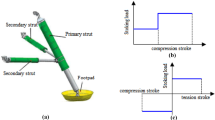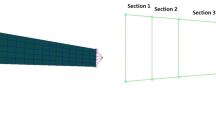Abstract
A soft landing directly influences the safety of devices and the follow-on work of a lander. Therefore, research on the interaction between the lander and the lunar regolith is of great significance. Different from the regular test experiments and finite element simulation, the landing impact is studied in a manner that combines a theoretical method and a discrete element simulation based on EDEM, which is more suitable for the simulation of the discrete particles due to the discontinuous properties of lunar regolith. Based on the properties of the lunar regolith and discrete element theory, this paper establishes the theoretical model and the discrete element model of the interaction between the lander and the lunar regolith. The influence of the lander structure and the lunar terrain on this interaction is analyzed through contrastive analysis of different work conditions.






































Similar content being viewed by others
References
Behm H (1967) Results of The Ranger, Lunar 9, and Surveyor 1 missions. J Astronaut Sci 14:101
Christensen EM, Batterson SA, Benson HE et al (1967) Lunar surface mechanical properties at the landing site of Surveyor 3. J Geophys Res Atmos 72(2):801–813
Papanastassiou DA, Wasserburg GJ (1971) Lunar chronology and evolution from Rb, Sr studies of Apollo 11 and 12 samples. Earth Planet Sci Lett 11(1–5):37–62
Dalrymple GB, Ryder G (1996) Argon-40/argon-39 age spectra of Apollo 17 highlands breccia samples by laser step heating and the age of the Serenitatis basin. J Geophys Res 101(E11):26069–26084
Ding L (2007) Institutional design and key technology research on the buffer mechanism of Lunar probe. Harbin Institute of Technology, Harbin
Ulesse JB (1969) Full-scale dynamic landing-impact investigation of a prototype lunar module landing gear. NASA TN D-5029
Benson HE (1970) Land and impact of the Apollo command module. AIAA-70-1165
Chen J, Nie H, Zhao J, Bai H, Bo W (2008) Performance analysis of buffer gear of lunar lander. Acta Astronaut 32(3):30–42
Ling DS, Jiang ZJ, Zhong SY et al (2013) Numerical study on impact of lunar lander footpad against simulant lunar soil. J Zhejiang Univ 47(7):1171–1177
Ling DS, Jiang ZJ, Cai WJ et al (2013) Experimental study of sliding forces of lander footpad in simulant lunar soil. Rock Soil Mech 34(7):1847–1853
Cundall PA (1971) A computer model for simulating progressive, large-scale movements in blocky rock systems. Proc Int Symp Rock Fracture 1(ii-b):11–8
Meguro K, Hakuno M (2010) Fracture analyses of concrete structures by the modified distinct element method. Doboku Gakkai Ronbunshu 410:113–124
Meguro K, Hatem TD (2000) Applied element method for structural analysis: theory and application for linear materials. 647:31–45. Jetty.ecn.purdue.edu
Cui J, Hou X, Deng Z et al (2017) Prediction of the temperature of a drill in drilling lunar rock simulant in a vacuum. Therm Sci 2015(00):51
Hou XY, Cui JS, Zhao DM et al (2014) Thermal test of lunar rock drill bit in vacuum environment. Appl Mech Mater 475–476(475–476):38–44
Cui J (2016) Research on mechanical-thermotics characteristics of drill-lunar regolith interaction and prediction of the temperature field. Harbin Institute of Technology, Harbin
Shen Y, Hou X, Qin Y et al (2014) Shape of mole nose providing minimum axial resistance. Robot Biomim 1(1):10
Shen Y, Hou X, Zhang K et al (2017) Study on the dynamic characteristics of a hammer-driven-type penetrators in the penetration process. Adv Mech Eng 9(3):168781401769411
Iturrioz I, Miguel LFF, Riera JD (2009) Dynamic fracture analysis of concrete or rock plates by means of the discrete element method. Latin Am J Solids Struct 6(3):229–245
Riera JD, Miguel LFF, Iturrioz I (2011) Strength of brittle materials under high strain rates in DEM simulations. Comput Model Eng Sci 82(2):113–136
Riera JD, Miguel LFF, Iturrioz I (2014) Assessment of Brazilian tensile test by means of the truss-like discrete element method (DEM) with imperfect mesh. Eng Struct 81:10–21
Iturrioz I, Riera JD, Miguel LFF (2014) Introduction of imperfections in the cubic mesh of the truss-like discrete element method. Fatigue Fract Eng Mater Struct 37(5):539–552
Kosteski LE, Riera JD, Iturrioz I et al (2015) Analysis of reinforced concrete plates subjected to impact employing the truss-like discrete element method. Fatigue Fract Eng Mater Struct 38(3):276–289
Bekkar MG (1969) Introduction to terrain-vehicle systems. University of Michigan Press, Ann Arbor
Oravec HA, Zeng X, Asnani VM (2010) Design and characterization of GRC-1: a soil for lunar terramechanics testing in Earth-ambient conditions. J Terrramech 47(6):361–377
Zou M, Jian-Qiao LI, Liu GM et al (2011) Experimental study of terra-mechanics characters of simulant lunar soil. Rock Soil Mech 32(4):1057–1061
Willman BM, Boles WW, Mckay DS et al (1995) Properties of lunar soil simulant JSC-1. Int J Rock Mech Min Sci Geomech Abstr 33(1):13A
Oravec B (2009) Understanding mechanical behavior of lunar soils for the study of vehicle mobility. Dissertations and Theses, Gradworks
Heiken GH, Vaniman DT, French BM (1991) Lunar sourcebook—a user’s guide to the moon. Cambridge University Press, Cambridge, United Kingdom
Acknowledgements
This work was financially supported by the National Nature Science Foundation of China (Grant Nos. 51505028, 51575123).
Author information
Authors and Affiliations
Corresponding author
Ethics declarations
Conflict of interest
The authors declare that there is no conflict of interests regarding the publication of this paper.
Additional information
Technical Editor: André Cavalieri.
Rights and permissions
About this article
Cite this article
Hou, X., Xue, P., Wang, Y. et al. Theoretical and discrete element simulation studies of aircraft landing impact. J Braz. Soc. Mech. Sci. Eng. 40, 115 (2018). https://doi.org/10.1007/s40430-018-0983-1
Received:
Accepted:
Published:
DOI: https://doi.org/10.1007/s40430-018-0983-1




